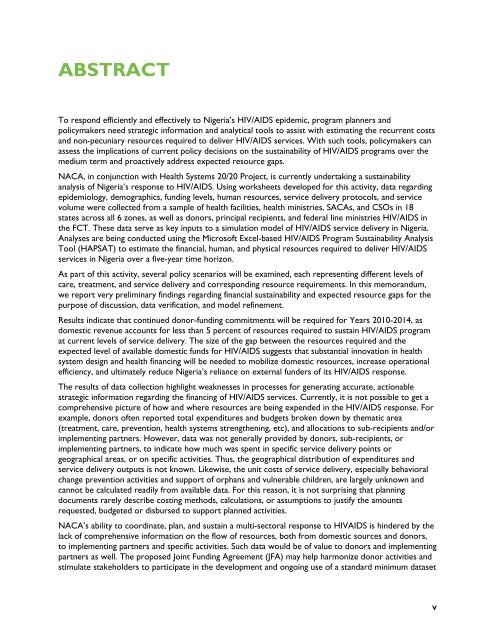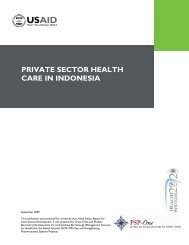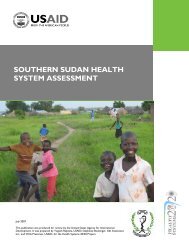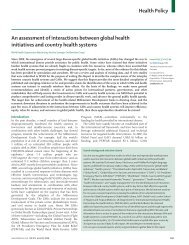SUSTAINABILITY ANALYSIS OF HIV/AIDS SERVICES IN NIGERIA
SUSTAINABILITY ANALYSIS OF HIV/AIDS SERVICES IN NIGERIA
SUSTAINABILITY ANALYSIS OF HIV/AIDS SERVICES IN NIGERIA
- No tags were found...
You also want an ePaper? Increase the reach of your titles
YUMPU automatically turns print PDFs into web optimized ePapers that Google loves.
ABSTRACTTo respond efficiently and effectively to Nigeria’s <strong>HIV</strong>/<strong>AIDS</strong> epidemic, program planners andpolicymakers need strategic information and analytical tools to assist with estimating the recurrent costsand non-pecuniary resources required to deliver <strong>HIV</strong>/<strong>AIDS</strong> services. With such tools, policymakers canassess the implications of current policy decisions on the sustainability of <strong>HIV</strong>/<strong>AIDS</strong> programs over themedium term and proactively address expected resource gaps.NACA, in conjunction with Health Systems 20/20 Project, is currently undertaking a sustainabilityanalysis of Nigeria’s response to <strong>HIV</strong>/<strong>AIDS</strong>. Using worksheets developed for this activity, data regardingepidemiology, demographics, funding levels, human resources, service delivery protocols, and servicevolume were collected from a sample of health facilities, health ministries, SACAs, and CSOs in 18states across all 6 zones, as well as donors, principal recipients, and federal line ministries <strong>HIV</strong>/<strong>AIDS</strong> inthe FCT. These data serve as key inputs to a simulation model of <strong>HIV</strong>/<strong>AIDS</strong> service delivery in Nigeria.Analyses are being conducted using the Microsoft Excel-based <strong>HIV</strong>/<strong>AIDS</strong> Program Sustainability AnalysisTool (HAPSAT) to estimate the financial, human, and physical resources required to deliver <strong>HIV</strong>/<strong>AIDS</strong>services in Nigeria over a five-year time horizon.As part of this activity, several policy scenarios will be examined, each representing different levels ofcare, treatment, and service delivery and corresponding resource requirements. In this memorandum,we report very preliminary findings regarding financial sustainability and expected resource gaps for thepurpose of discussion, data verification, and model refinement.Results indicate that continued donor-funding commitments will be required for Years 2010-2014, asdomestic revenue accounts for less than 5 percent of resources required to sustain <strong>HIV</strong>/<strong>AIDS</strong> programat current levels of service delivery. The size of the gap between the resources required and theexpected level of available domestic funds for <strong>HIV</strong>/<strong>AIDS</strong> suggests that substantial innovation in healthsystem design and health financing will be needed to mobilize domestic resources, increase operationalefficiency, and ultimately reduce Nigeria’s reliance on external funders of its <strong>HIV</strong>/<strong>AIDS</strong> response.The results of data collection highlight weaknesses in processes for generating accurate, actionablestrategic information regarding the financing of <strong>HIV</strong>/<strong>AIDS</strong> services. Currently, it is not possible to get acomprehensive picture of how and where resources are being expended in the <strong>HIV</strong>/<strong>AIDS</strong> response. Forexample, donors often reported total expenditures and budgets broken down by thematic area(treatment, care, prevention, health systems strengthening, etc), and allocations to sub-recipients and/orimplementing partners. However, data was not generally provided by donors, sub-recipients, orimplementing partners, to indicate how much was spent in specific service delivery points orgeographical areas, or on specific activities. Thus, the geographical distribution of expenditures andservice delivery outputs is not known. Likewise, the unit costs of service delivery, especially behavioralchange prevention activities and support of orphans and vulnerable children, are largely unknown andcannot be calculated readily from available data. For this reason, it is not surprising that planningdocuments rarely describe costing methods, calculations, or assumptions to justify the amountsrequested, budgeted or disbursed to support planned activities.NACA’s ability to coordinate, plan, and sustain a multi-sectoral response to <strong>HIV</strong><strong>AIDS</strong> is hindered by thelack of comprehensive information on the flow of resources, both from domestic sources and donors,to implementing partners and specific activities. Such data would be of value to donors and implementingpartners as well. The proposed Joint Funding Agreement (JFA) may help harmonize donor activities andstimulate stakeholders to participate in the development and ongoing use of a standard minimum datasetV
















